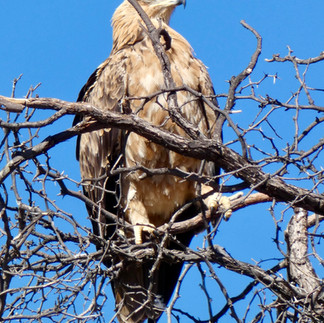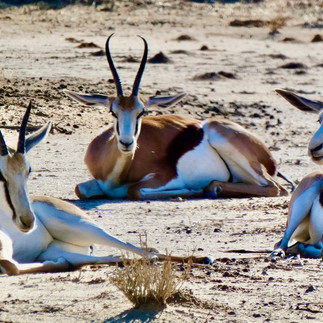The lions of Rooiputs
- Jan Dehn

- Jun 12, 2023
- 4 min read
Updated: Apr 27

Kgalagadi is the Setswana word for Kalahari, a 900,000 square kilometres desert, which covers most of Botswana as well as parts of South Africa and Namibia. In the heart of the Kalahari, you find the Kgalagadi Transfrontier Park, which straddles South Africa’s Northern Cape Province and the south-western corner of Botswana. The Nossob and Auob rivers, dry most of the year, stretch the length and breadth of the park. On the Botswana side of the Nossob, nestled in the park’s south eastern corner, you will find the Rooiputs lodge and campsite.

The Rooiputs Lodge undersells itself, though possibly not intentionally. It is built along the ridge of an east-facing dune of loose red sand. Wooden huts with spectacular views of each morning’s sunrise radiate out from either end of the thatched central building, which contains a simple dining area as well as a terrace suited for the enjoyment of sundowners.
While the Rooiputs Lodge is indisputably rustic, it makes up for its lack of sophistication with a relaxing atmosphere, warm and personal service, delicious home-cooked food, and large G&Ts served with lots of ice and freshly cut slices of lemon.
More importantly, Rooiputs Lodge offers a genuine sense of remoteness and a real feel of Botswana that sets the lodge apart from its South African competitors, where, sadly, you never quite escape the echoes of apartheid that still linger in all interactions between people.
Rooiputs is known for its black-maned lions.
The lions do not take long to manifest themselves. Within minutes of our arrival, Benjamin, the lodge’s guide, takes us to see two couples of large lions languishing in a dune just meters away from one of the huts. As we watch, one of the large male lions rises from his slumber to mount a female in brief but intense intercourse. The other male lion, its brother, relaxes next to its partner. Both have undoubtedly copulated prodigiously earlier in the day.



Next morning, after a night with a gorgeous new moon, we wake to the distinctive sounds of lions roaring.

We find five of them in brilliant morning sunshine just a kilometre from the lodge: two large males, two mature females, and a young. All highly active. As they move towards us, their yellow-orange eyes light up from the rays of the low sun at our backs.

Rooiputs offers more than lions. Having only ever once seen a honey badger at Moremi in Botswana, we are treated to no fewer than six honey badgers around Rooiputs during two days of game driving along the lower section of the Nossob River. Two of the honey badgers travel together like a couple, or siblings.

We spot another honey badger as it approaches a cheetah perched on the shrub-covered crest of a dune. It shows not the slightest fear. I manage to snap a rare honey badger/cheetah combo.

Around 11.00 in the morning on the second day’s game drive, as we are heading back to Rooiputs Lodge, we spot a giraffe awkwardly prostrating itself in pursuit of water.

A short distance away a lone young hartebeest grazes close to the road. Its horns have not yet grown apart. As I take the picture, I am unaware that this is the last picture anyone will ever take of this animal alive.

Hardly have I lowered my camera before a large cheetah emerges a few hundred meters away, clearly stalking the hartebeest. With immaculate precision, the cheetah approaches the hartebeest in a series of low crouches that take it from one bush to the next, out of sight of its intended prey.

When the cheetah runs out of bushes, it rises to its full height in a slow steady movement and proceeds to advance towards the hartebeest one foot at a time, freezing every time the hartebeest looks up. For five minutes the painstaking hunt continues. Then the cheetah is finally close enough. The hartebeest still has no idea it is being stalked. Suddenly the cheetah bursts into a ferocious sprint. Within just seconds, it is moving at blistering speed. Closes in on the hartebeest a full 10 meters before its prey is even aware of its attacker. Then the hartebeest turns. Bolts. Up a low dune. Down the other side. Across the road. At frenetic speed.

But it is too late. Within seconds it is all over. Just across the road, the cheetah catches the hind leg of the hartebeest. Both crash to the ground in a cloud of dust. When the dust settles, the neck of the hartebeest is clamped firmly in the cheetah’s jaws; as it slowly suffocates, its jerky movements slow until, finally, they end completely.

As the hartebeest lies motionless beneath it, the breathing of the cheetah gradually subsides. But it still takes a full ten minutes before the cheetah tries to move the antelope. As it catches its breath, the cheetah scans its surroundings. But today it is alone and its prey is safe. When the cheetah has finally regained its strength, it drags the hartebeest into the shade of a nearby tree and begins to consume its breakfast.

A jackal has followed every step of the hunt from a distance. Its patience will be rewarded. It licks its lips.
Kgalagadi offers a variety of other game and birdlife in addition to the big predators. The Pale Chanting Goshawk, known locally as the Kalahari Chicken on account of its abundance, is found all over the park. In addition, there are frequent sighting of other raptors, such as Verreaux’s Eagle Owl, Bateleur Eagle, Martial eagle, and Tawny Eagle. Or possibly the Brown Snake Eagle, though the latter is an infrequent visitor. In addition to raptors, there are colourful Lilac-breasted rollers.

You also see hornbills, several different species of Korhaans as well as the mighty Kori Bustard.

The lions of Rooiputs have plenty of food. The Nossob river bed is replete with Springbok, Steenbok, Blue Wildebeest, Ostrich, Giraffe, and the Oryx after which the park was formerly named (Gemsbok National Park).
Also, expect to see Meerkat and Yellow Mongoose as well as many rodents. On the other hand, you will not see much in the way of baboon, warthog, elephant, zebra, buffalo, and other species that require an abundance of water for their survival. After all, Kgalagadi is a desert game park.
The End




























Comments